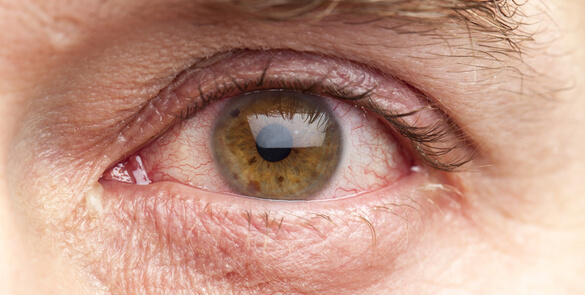What is Meibomian Gland Dysfunction?
Meibomian Gland Dysfunction (MGD), also known as meibomian gland disease, is a common condition in which the oil-producing glands in the eyelids become blocked or do not function properly. These glands are essential in maintaining a healthy tear film, which keeps the surface of the eye moist and comfortable.
When the glands are not functioning correctly, the tear film becomes unstable and evaporates too quickly. This can lead to dry, irritated, or uncomfortable eyes. This condition is particularly common in older adults, but it can also affect individuals of any age.
At Moorfields Eye Hospital Dubai and Abu Dhabi, we offer advanced diagnostic tools and evidence-based treatment options to help manage Meibomian Gland Dysfunction and improve your long-term eye comfort and vision

What are the causes and risk factors of Meibomian Gland Dysfunction?
The underlying cause of MGD is often a blockage or abnormality in the meibomian glands. While the precise cause is not always known, several factors contribute to the development of dysfunctional meibomian glands:
- Aging: As we age, the meibomian glands naturally produce less oil, increasing the risk of the condition.
- Hormonal changes: Hormonal fluctuations, particularly during menopause, can affect gland function.
- Chronic blepharitis: Blepharitis, an inflammation of the eyelids, often present alongside MGD, can worsen symptoms.
- Environmental factors: Prolonged exposure to dry or windy conditions, air conditioning, and excessive screen time can contribute to the development of MGD.
- Contact Lens use: Wearing contact lenses can interfere with the normal functioning of the meibomian glands.
- Makeup use: Frequently using eye makeup like eyeliner.
Individuals with certain underlying conditions, such as rosacea or other inflammatory skin disorders, are also at a higher risk of developing meibomianitis, a specific form of MGD characterised by inflammation of the meibomian glands.
What are the symptoms of Meibomian Gland Dysfunction?
The symptoms of meibomian gland dysfunction are very similar to those of dry eye syndrome and include:
- Itchy and red eyes
- A persistent feeling of dryness or grittiness in the eyes
- Blurry vision, particularly after prolonged use of digital devices
- Swollen, red eyelid margins (blepharitis)
These symptoms may fluctuate throughout the day and can worsen in certain environments, such as air-conditioned rooms or outdoors on windy days.
How is Meibomian Gland Dysfunction diagnosed?
Accurate diagnosis of meibomian gland dysfunction is essential for effective treatment. Eye care professionals use various diagnostic procedures to assess the function of the meibomian glands:
- Meibography: This imaging scan allows the visualisation of the meibomian glands to assess their structure and function.
- Tear film analysis: Evaluating the tear film’s composition can help identify abnormalities caused by MGD.
- Expression Testing: The doctor may apply gentle pressure to the eyelids to evaluate the quality and quantity of oil secretion from the glands.
- Slit lamp examination: Checking your eyelid structure with a special light called a slit lamp
These diagnostic tools provide a comprehensive understanding of the condition and guide the most appropriate treatment plan.
Various treatments for meibomian gland dysfunction are available, ranging from simple home care measures to advanced medical therapies. The treatment approach depends on the severity of the condition and the patient’s specific needs.
Basic treatments: Warm Compresses and Medications
- Warm Compresses: Applying a warm compress for 5-10 minutes to the eyelids can help to melt the blocked oils within the meibomian glands. After warming, gently massaging the eyelids can further help, promoting natural secretion and relieving symptoms.
- Medications: In some cases, doctors may prescribe medications, such as antibiotics, steroid eye drops, or even omega-3 supplements to help relieve symptoms.
These treatments are typically the first line of defence and can effectively manage mild to moderate cases of blocked meibomian glands.
Advanced Treatments: LipiFlow and Other Therapies
For more severe cases, advanced treatments are available:
- LipiFlow®: A specialised and a state-of-the-art treatment that combines heat and gentle pressure to unclog blocked meibomian glands. This procedure effectively restores normal gland function and provides long-term relief.
- Intense Pulsed Light (IPL) Therapy: A light therapy that helps treat moderate-to-severe chronic dry eye disease and MGD. It works by heating the meibomian glands and liquifying the oils, reducing inflammation and redness
- BlephEx®: This treatment involves thoroughly cleaning the eyelids to remove debris and bacterial buildup that can contribute to MGD.
Managing Meibomian Gland Dysfunction
Managing MGD is an ongoing process. Patients are encouraged to:
- Maintain daily eyelid hygiene using warm compresses and eyelid cleansers
- Use prescribed treatments consistently
- Limit environmental triggers when possible
- Attend regular follow-ups with their eye care provider
With the right care plan, symptoms can be effectively managed, and long-term eye health preserved.
Request an Appointment





